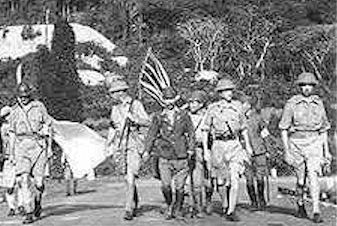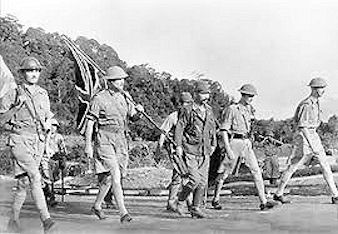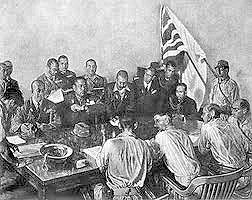The Fall of Singapore
Overview
By the 31st. January 1942, all British Empire Forces had withdrawn from the Malay peninsula onto Singapore Island. On the 8th. February, the Japanese landed in the north-west of the island and within six days they were on the outskirts of Singapore City, which was also now under constant air attack. Many of the troops had been shocked at the apparent lack of defences on the island. The men were battle-weary and the Australians had lost nearly 700 men fighting in Malaya since the 14th. January, with hundreds of others sick or wounded. Only one trained reinforcement unit, the 2/4th Machine Gun Battalion, arrived from Australia. Other last-minute reinforcements sent were untrained and ill-equipped for battle.
The Japanese had prepared for the invasion of Singapore with a heavy bombardment. They began their amphibious landings on the north-west of the island, where the Strait of Johore is narrowest. This area was held by the Australian 22nd Infantry Brigade but late on the night of the 8th. February the Japanese made their way through undefended sections. Twenty-four hours later a second Japanese landing force struck between the Causeway and the mouth of the Kranji River, an area held by the Australian 27th Infantry Brigade. By the morning of the 10th. February there were Japanese troops on most of north-west Singapore.
The Australian, British and Indian troops tried to hold the Japanese at various defensive lines but after two days many of their dreadfully depleted Battalions had to be reorganised into composite units. A counter-attack on the 10th. - 11th. February failed and on the 12th. February, General H. Gordon Bennett, the Australian Commander, began moving his near-exhausted 8th Division AIF units into a perimeter just a few kilometres out of the city. By the next day the Japanese were within five kilometres of the Singapore waterfront. The entire city was now within range of Japanese artillery.
Official evacuations from Singapore had begun in late January and continued until almost the last moment. Airforce Squadrons had been evacuated before the Japanese invaded the island and the remaining Naval warships were ordered to leave. Some merchant ships also got away carrying evacuees from the path of the Japanese. During the two and a half months before the Allied surrender, the local Chinese and Indian population suffered shockingly from the Japanese air raids. By the 14th. February the Japanese had captured Singapore's reservoirs and pumping stations. The bombing, fighting and heavy shelling continued; many of the troops, separated from their units, wandered around aimlessly and the hospitals were crowded and overflowing. Some troops were deserting and others had become separated from their units. Hard fighting continued but on the 15th. February 1942, Lieutenant General Arthur Percival, the British Commander in Singapore, called for a ceasefire and made the difficult decision to surrender. He signed the surrender document that evening at the Ford Factory on Bukit Timah Road.
After days of desperate fighting, all British Empire troops were to lay down their arms at 2030hrs that night. More than 100,000 troops became prisoners of war together with hundreds of European civilians who were interned.
 |
 |
 |
|
